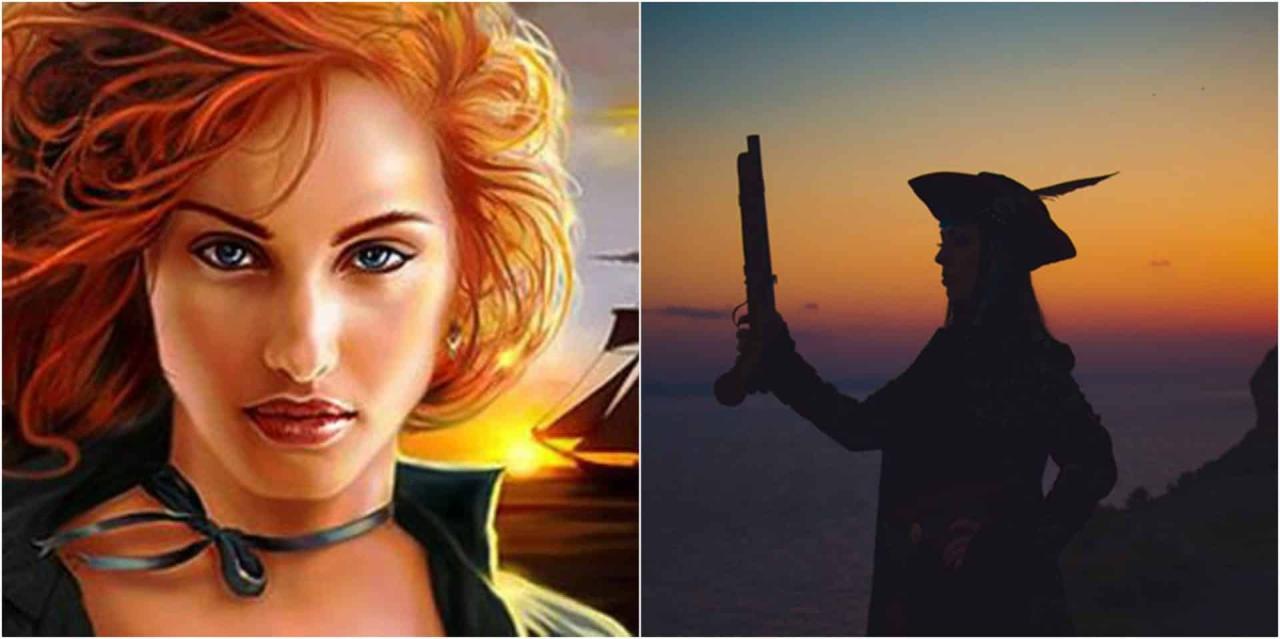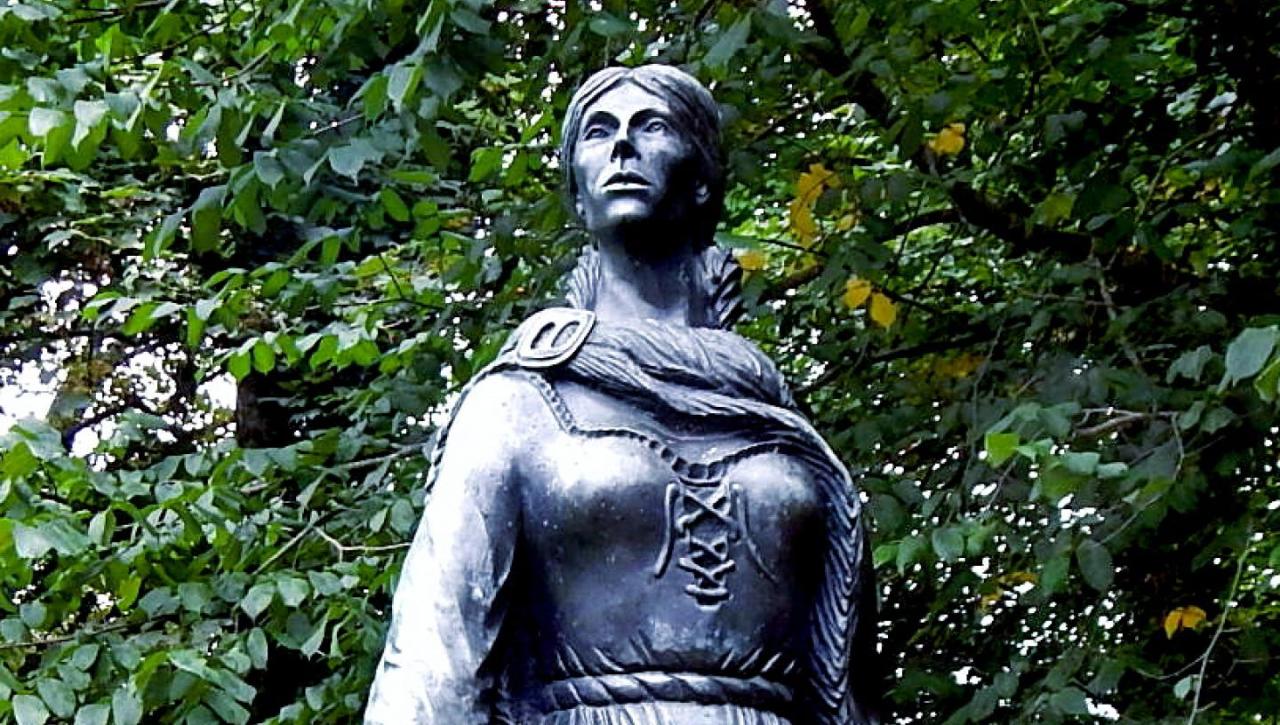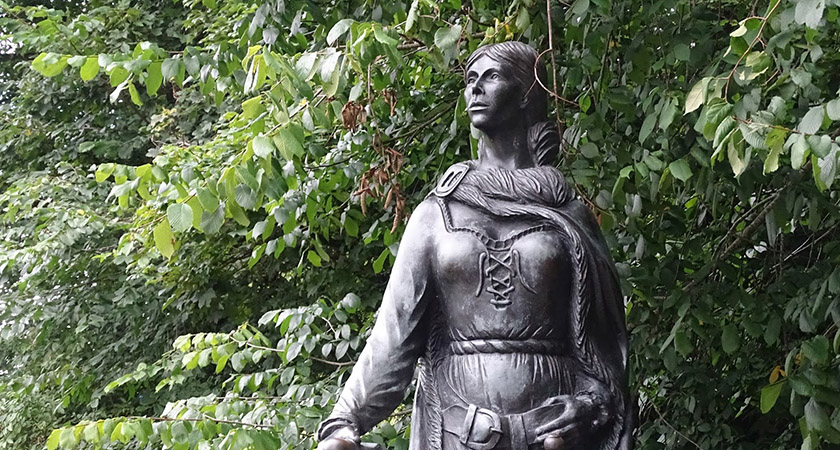Grace o’marcaigh – Grace O’Malley, the legendary Irish pirate queen, emerges from the annals of history as a captivating figure whose life and exploits continue to fascinate and inspire generations.
Her story is a testament to her indomitable spirit, strategic brilliance, and unwavering commitment to her people, making her a symbol of Irish resilience and independence.
Grace O’Malley’s Early Life and Family Background
Grace O’Malley, also known as Gráinne Ní Mháille, was born into a prominent maritime family in the mid-16th century in County Mayo, Ireland. Her father, Eoghan Dubhdara Ó Máille, was the chieftain of the Ó Máille clan, a powerful seafaring dynasty that controlled a large portion of the west coast of Ireland.
From a young age, Grace was immersed in the maritime culture of her family. She learned to sail and navigate at an early age, and she often accompanied her father on his trading and raiding expeditions. This upbringing gave her a deep understanding of the sea and its ways, and it laid the foundation for her future career as a pirate queen.
Her Family Lineage
Grace O’Malley’s family had a long and distinguished history in maritime affairs. Her ancestors had been seafarers for centuries, and they had established a reputation for their skill and bravery. Grace’s father, Eoghan Dubhdara, was a renowned warrior and pirate, and he was known for his daring raids on English ships.
Grace’s mother, Margaret O’Malley, was also a strong and independent woman. She was a skilled navigator and tactician, and she often accompanied her husband on his expeditions. Grace inherited her mother’s intelligence and determination, and she quickly became a skilled sailor and warrior in her own right.
Rise to Prominence as a Pirate Queen
Grace O’Malley’s rise to prominence as a pirate queen was a culmination of several factors. Her strategic alliances, leadership abilities, and daring raids played a pivotal role in shaping the political landscape of the time.
Leadership Skills and Strategies
O’Malley possessed exceptional leadership skills. She commanded a fleet of over 200 galleys and led her crews with authority and respect. Her strategic acumen was evident in her tactics, which involved surprise attacks, ambushes, and hit-and-run raids. She exploited the weaknesses of her opponents, often targeting merchant ships and coastal settlements.
Impact on Political Landscape
O’Malley’s raids and alliances had a significant impact on the political landscape of the time. Her alliance with the Scottish Clan Donald strengthened her position against the English. She negotiated with both the English and Irish governments, securing favorable terms for her people and challenging the authority of the English crown.
Conflict with the English
Grace O’Malley’s conflicts with the English authorities arose from several factors, including territorial disputes, political ambitions, and economic interests.
English Expansion and Irish Resistance
- The English sought to expand their control over Ireland, threatening the autonomy of Irish clans like the O’Malleys.
- Irish clans, including O’Malley’s, resisted English encroachment, leading to armed conflicts and skirmishes.
Battle of Inishbofin
One notable battle between O’Malley’s forces and the English navy occurred in 1586 at Inishbofin.
- O’Malley’s galleys engaged in a fierce sea battle against English ships led by Sir Richard Bingham.
- Despite being outnumbered, O’Malley’s forces fought valiantly, inflicting heavy losses on the English.
Diplomatic Negotiations
In addition to military confrontations, diplomatic efforts were also made to resolve the conflict.
- In 1588, O’Malley met with Queen Elizabeth I in England to negotiate a truce.
- The negotiations were unsuccessful, as O’Malley refused to accept English authority over her territories.
Alliances and Political Maneuvers
Grace O’Malley forged strategic alliances with other Irish clans and leaders to strengthen her position and maintain her independence. These alliances played a crucial role in her ability to resist English encroachment and pursue her own political agenda.
Clan Alliances, Grace o’marcaigh
O’Malley allied herself with powerful Irish clans, including the O’Flahertys, the O’Malleys, and the Joyces. These alliances provided her with military support, access to resources, and a network of informants. By uniting with other clans, O’Malley could present a united front against English forces and negotiate from a position of strength.
Grace O’Marcaigh, an Irish journalist, is married to Woj, a Polish man. Woj is a professional basketball coach, and the couple has two children together. O’Marcaigh has written extensively about her experiences as a wife and mother, and her work has been praised for its honesty and humor.
You can read more about her experiences as a “woj wife” here. O’Marcaigh is a talented writer who has a unique perspective on life. Her work is sure to resonate with anyone who has ever been a wife or a mother.
Political Negotiations
O’Malley engaged in skillful political negotiations with both Irish and English factions. She played different groups against each other, exploiting their rivalries to her advantage. For example, she allied with the English Lord Deputy of Ireland, Sir Henry Sidney, in order to gain concessions from the English government. However, she also maintained ties with Irish rebel leaders, ensuring that she had options if negotiations with the English failed.
Grace O’Marcaigh, the renowned Irish painter, exhibited her work alongside Marc Agnifilo , an Italian artist known for his expressive abstract paintings. Their joint exhibition showcased the diverse range of artistic styles and perspectives within the contemporary art world. Grace O’Marcaigh’s vibrant landscapes and intimate portraits contrasted with Marc Agnifilo’s bold and gestural compositions, creating a dynamic and captivating display.
Leadership and Legacy
Grace O’Malley was a charismatic and influential leader who commanded the respect and loyalty of her followers. She was known for her courage, determination, and strategic brilliance, which she used to protect her people and their interests.
O’Malley’s leadership style was characterized by a combination of firmness and compassion. She was strict and demanding when necessary, but she also cared deeply for her people and was always willing to fight for their rights. Her followers were inspired by her example and were willing to follow her into battle or on any other dangerous mission.
Reputation as a Fearless and Respected Figure
Grace O’Malley was a fearless and respected figure in Irish history. She was known for her courage and determination, as well as her strategic brilliance. She was also a skilled negotiator and diplomat, and she was able to forge alliances with powerful figures both in Ireland and abroad.
O’Malley’s reputation as a fearless and respected figure continues to inspire and resonate with people today. She is seen as a symbol of Irish independence and resilience, and her story continues to be told and retold in books, films, and other media.
Legacy
Grace O’Malley’s legacy continues to inspire and resonate with people today. She is seen as a symbol of Irish independence and resilience, and her story continues to be told and retold in books, films, and other media.
O’Malley’s legacy is also evident in the many places that are named after her, including Grace O’Malley Island in County Mayo and Grace O’Malley’s Pub in Dublin. She is also the subject of a number of statues and monuments, including a statue in Galway City and a monument in Westport, County Mayo.
Cultural Impact and Representation: Grace O’marcaigh
Grace O’Malley’s story has had a profound impact on Irish culture and identity. Her image has been used in art, music, and literature for centuries, and her legend continues to inspire Irish people today.
In Irish Folklore and Literature
Grace O’Malley is a central figure in Irish folklore and literature. She is often depicted as a powerful and independent woman who fought against the English and defended her people. Her story has been told in countless tales, songs, and poems, and she has become a symbol of Irish resistance and resilience.
In Art and Music
Grace O’Malley has also been the subject of numerous works of art and music. She has been depicted in paintings, sculptures, and other forms of visual art, and her story has been told in songs, operas, and other musical compositions. These works of art have helped to keep her legend alive and have contributed to her status as a national icon.
In Irish Identity and National Consciousness
Grace O’Malley’s legend has played a significant role in shaping Irish identity and national consciousness. She is seen as a symbol of Irish strength and independence, and her story has helped to inspire Irish people in their struggles for freedom and self-determination. Her legend continues to be celebrated in Ireland today, and she remains an important figure in Irish culture and society.
Grace O’Malley was renowned for her exceptional maritime skills and naval warfare expertise. She possessed an intimate knowledge of the Irish coast and its treacherous waters, enabling her to navigate with precision and evade capture.
Her fleet consisted of swift and maneuverable galleys, known as “galleasses.” These vessels were equipped with sails and oars, providing them with both speed and flexibility in combat. O’Malley’s ships were also armed with cannons and other weapons, making them formidable opponents in naval battles.
Tactics and Strategy
In battle, O’Malley employed a combination of stealth, surprise, and aggressive tactics. She often attacked English ships at night or during storms, taking advantage of the element of surprise. Her galleys were highly maneuverable, allowing her to outmaneuver larger and slower English vessels.
O’Malley also utilized hit-and-run tactics, striking at English ships, then quickly withdrawing before they could retaliate. This strategy allowed her to inflict significant damage while minimizing her own losses.
Historical Context and Social Conditions
Grace O’Malley emerged during a tumultuous period in Irish history, marked by political instability, economic hardships, and social upheaval.
Ireland in the 16th century was a land divided between Gaelic chiefdoms and English settlements. The English Crown sought to assert its control over the island, leading to conflicts and rebellions.
Role of Women in Irish Society
Irish society was patriarchal, with women having limited rights and opportunities. They were primarily responsible for domestic duties and raising children.
However, some women, like Grace O’Malley, defied societal norms and played significant roles in public life. They held positions of authority within their clans, participated in warfare, and engaged in trade and diplomacy.
Challenges Faced by Women
Women in 16th-century Ireland faced numerous challenges. They were often excluded from political decision-making, had limited access to education, and were subject to societal expectations and biases.
Grace O’Malley’s experiences and achievements reflected the broader social and historical forces of her time. She challenged gender norms, asserted her authority, and navigated the complex political landscape of her era.
Geographical Locations and Territories
Grace O’Malley’s life and activities were centered around key geographical locations in Ireland and beyond. Her stronghold on Clare Island in County Mayo served as her primary base of operations. From there, she launched raids along the western coast of Ireland, targeting English settlements and ships.
Strategic Importance
These locations played a crucial role in Grace O’Malley’s military and political campaigns. Clare Island provided her with a secure base, protected by its rugged terrain and strategic position at the entrance to Clew Bay. Her raids along the Irish coast allowed her to control vital sea routes and disrupt English trade and communication. By controlling these areas, Grace O’Malley was able to exert significant influence over the political and economic landscape of Ireland.
Key Locations
– Clare Island: Grace O’Malley’s stronghold and base of operations.
– Clew Bay: A sheltered bay that provided protection for Grace O’Malley’s ships.
– Aran Islands: A group of islands off the coast of Galway that served as a refuge for Grace O’Malley and her followers.
– Galway Bay: A strategically important body of water that Grace O’Malley controlled through her alliances with local clans.
– Lough Foyle: A fjord in County Donegal where Grace O’Malley had a castle and engaged in battles with the English.
Comparisons with Other Historical Figures
Grace O’Malley stands as a remarkable figure in history, with her achievements and legacy comparable to other notable individuals. By examining her similarities and differences with other historical figures, we gain a deeper understanding of her unique place in the annals of history.
Female Pirates
- Anne Bonny and Mary Read: Like Grace O’Malley, Anne Bonny and Mary Read were renowned female pirates who defied societal norms and carved out their own paths on the high seas. All three women exhibited exceptional courage, leadership skills, and a willingness to challenge authority.
- Ching Shih: The Chinese pirate queen Ching Shih commanded a vast fleet and amassed immense wealth during the early 19th century. Both Grace O’Malley and Ching Shih were successful military strategists who used their maritime prowess to gain political influence and challenge established powers.
Military Leaders
- Joan of Arc: Joan of Arc, the French peasant girl who led her people to victory against the English, shares similarities with Grace O’Malley in their unwavering determination and ability to inspire others. Both women faced adversity and prejudice, yet they remained steadfast in their pursuit of their goals.
- Boudicca: The Celtic queen Boudicca, who led a rebellion against Roman rule, fought for the independence of her people, just as Grace O’Malley did for her clan. Their courage and leadership qualities made them formidable opponents to their enemies.
Political Figures
- Elizabeth I: Queen Elizabeth I of England, a contemporary of Grace O’Malley, was a powerful and influential monarch who navigated complex political alliances. Both women demonstrated diplomatic skills and a keen understanding of power dynamics.
- Catherine the Great: The Russian empress Catherine the Great expanded her empire and implemented progressive reforms. Like Grace O’Malley, Catherine the Great was a shrewd and ambitious ruler who left a lasting mark on history.
These comparisons highlight the extraordinary qualities of Grace O’Malley and her place among other historical figures who defied expectations, broke barriers, and shaped the course of history.
Conclusion
Grace O’Malley’s legacy extends far beyond her lifetime, as her story has been immortalized in folklore, literature, and popular culture, serving as a timeless reminder of the power of human determination and the enduring spirit of the Irish people.
Essential Questionnaire
When was Grace O’Malley born?
The exact date of Grace O’Malley’s birth is unknown, but it is estimated to be around 1530.
What was Grace O’Malley’s nickname?
Grace O’Malley was known by the nickname “Granuaile,” which means “Grace the Bald.”
How many children did Grace O’Malley have?
Grace O’Malley had four children: three sons and one daughter.
What was the name of Grace O’Malley’s most famous ship?
Grace O’Malley’s most famous ship was called the “Galley of the West.”



